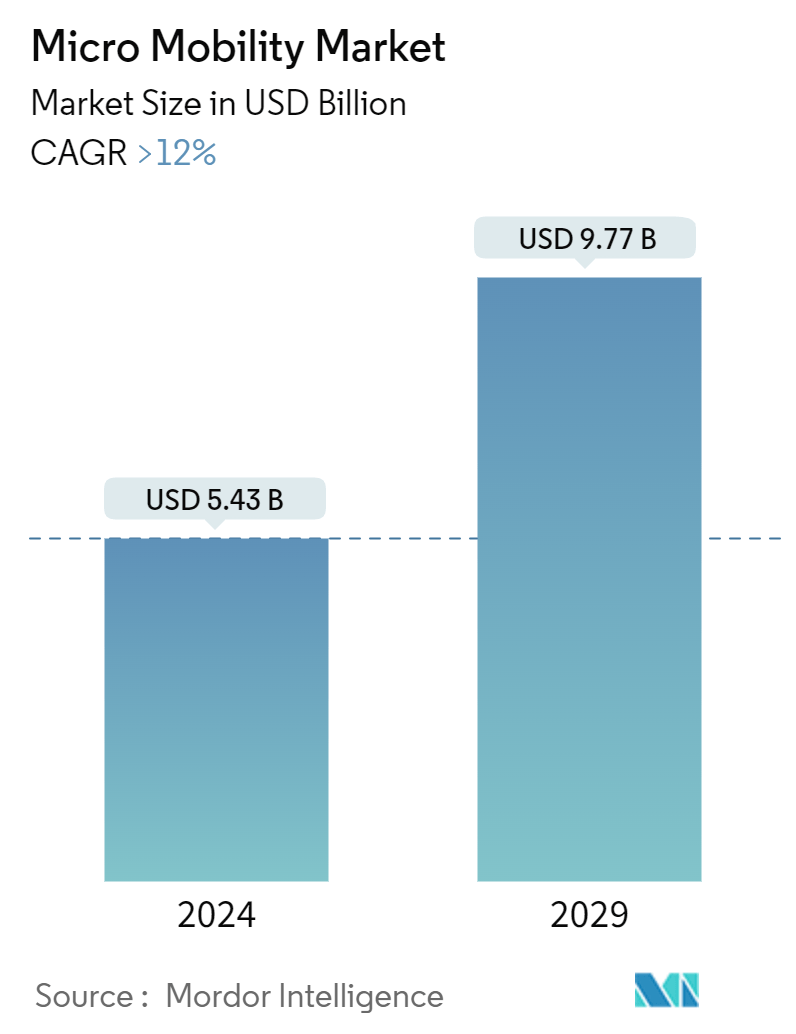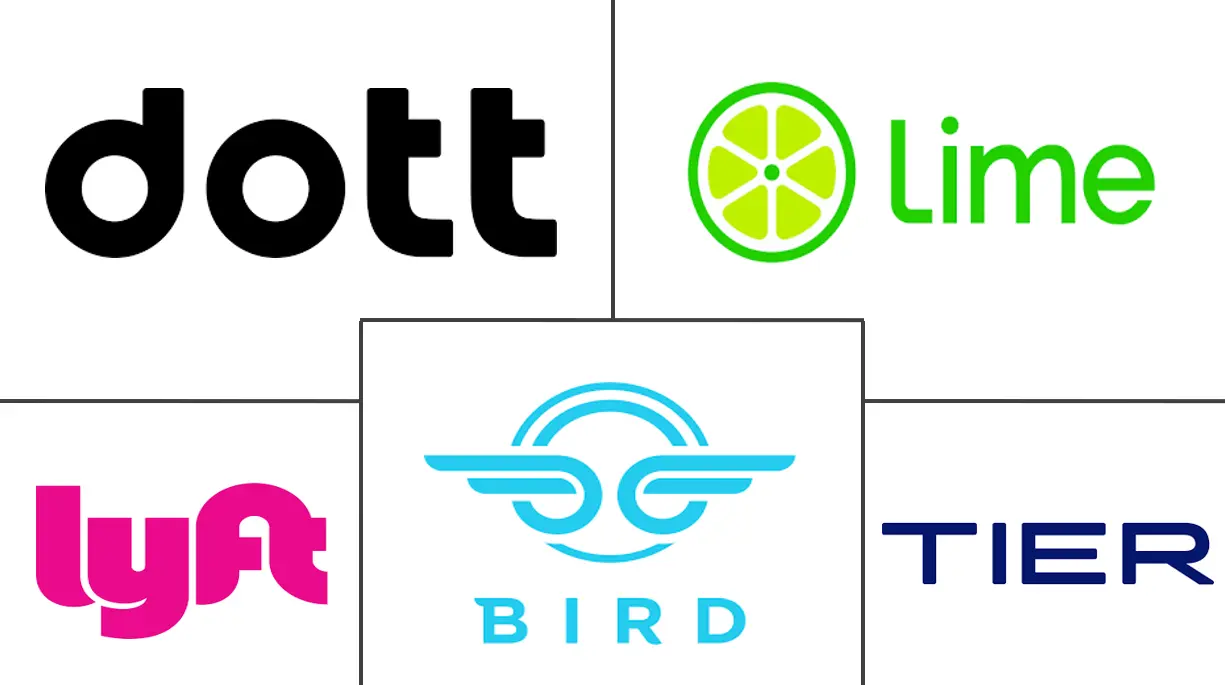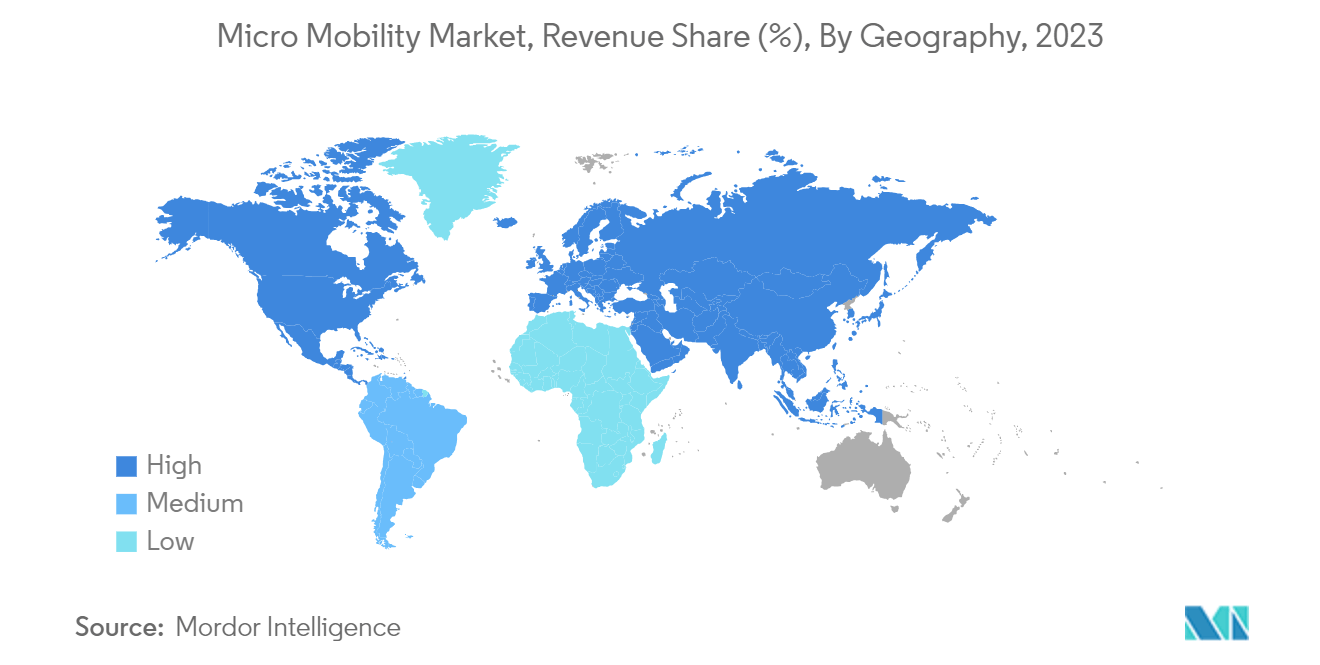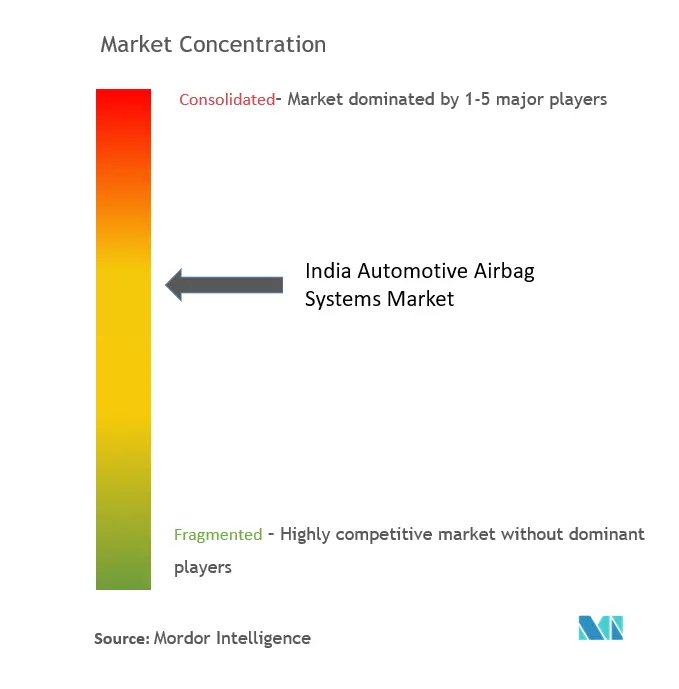Micro Mobility Market Size

| Study Period | 2019 - 2029 |
| Market Size (2024) | USD 5.43 Billion |
| Market Size (2029) | USD 9.77 Billion |
| CAGR (2024 - 2029) | 12.00 % |
| Fastest Growing Market | Asia Pacific |
| Largest Market | North America |
Major Players
*Disclaimer: Major Players sorted in no particular order |
Micro Mobility Market Analysis
The Micro Mobility Market size is estimated at USD 5.43 billion in 2024, and is expected to reach USD 9.77 billion by 2029, growing at a CAGR of greater than 12% during the forecast period (2024-2029).
The global micromobility market is driven by increasing urban congestion and a shift toward sustainable transportation solutions. Cities worldwide are adopting micromobility as a flexible, cost-effective, and environmentally friendly alternative to traditional vehicular transport. This market includes lightweight transportation modes such as e-scooters, e-bikes, and shared bicycles.
In response to environmental concerns and urban traffic, governments and municipalities are implementing policies that promote micromobility.
- In 2022, micromobility systems helped offset approximately 74 million pounds of CO₂ emissions by replacing car trips. Usage of these systems has seen a significant rise, with total trips increasing Y-o-Y and accounting for a substantial reduction in carbon emissions.
The COVID-19 pandemic influenced investment trends in the micromobility industry. After a decline in 2020, investments rebounded in 2021, with approximately USD 2.9 billion flowing into the industry. The geographic and vehicle focus of these investments has shifted, with Europe emerging as a leading investment destination, surpassing Asia due to aggressive infrastructural and policy enhancements that promote micromobility. E-kick scooters have attracted the most investment, underscoring their popularity and the consolidation trend within the industry.
Further, technological advancements are central to the expansion of the micromobility industry. Innovations in battery technology, GPS tracking, and mobile connectivity have improved the user experience and operational efficiency. Companies are increasingly focusing on app-based services and IoT integration, which facilitate better service management and user engagement.
However, challenges such as regulatory inconsistencies, safety concerns, and the economic sustainability of business models remain. Despite these challenges, the micromobility market is expected to grow significantly during the forecast period, with increasing consumer adoption and ongoing investments.
Micro Mobility Market Trends
Docked Micromobility Paving the Way for Sustainable Urban Transportation
The docked segment is projected to dominate the micromobility market during the forecast period. This can be attributed to a combination of factors that cater to both service providers' and users' preferences. The reliability and structure of docked systems have made them a leading choice, generating substantial value on a global scale. The provision of designated stations for docking micromobility vehicles such as bikes and scooters appeals to users, simplifying the process of hiring and returning these vehicles while being assured of a sense of security and convenience.
Docked systems mitigate the risks of theft and vandalism, a common concern associated with dockless alternatives, thus offering a more sustainable and dependable service. The availability of dedicated infrastructure also indicates a higher demand for station-based solutions, which, in turn, fuels further investments and developments within the industry.
In addition, key players such as Swiftmile, Charge, and Charge are actively expanding their networks, focusing on the strategic placement of stations on private properties and collaborating with parking facilities to enhance accessibility. For instance,
- In February 2023, Lyft disclosed its plan to introduce dockable e-scooters, aiming to create a more organized shared micromobility landscape.
These developments, supported by a growing preference for sustainable urban transportation options, suggest a robust future for the docked micromobility segment as a market leader.

The Asia-Pacific Micromobility Market is the Fastest-growing Globally
Asia-Pacific is the fastest-growing regional market for micromobility globally due to a multitude of factors. The region has a high urban population density, which fosters the demand for efficient, affordable, and flexible transportation options to alleviate the challenges of traffic congestion and air pollution. As economies in the region grow, there is a rising middle-income group with disposable incomes, yet many individuals in these populations look for cost-effective travel solutions.
Moreover, investments in smart city projects across Asia-Pacific countries have led to an integration of micromobility services with public transportation systems to offer last-mile connectivity, which is essential in sprawling urban areas. In addition, the technological adoption rate is high, with consumers readily embracing app-based services for transportation. The proliferation of smartphones and internet connectivity has made access to micromobility platforms easier, contributing to their growth.
Furthermore, several governments in Asia-Pacific have started to implement favorable regulations and policies that encourage the use of micromobility services. These include investments in infrastructure, such as dedicated bike lanes and parking spots for docked and dockless vehicles, which improve safety and accessibility for users.
- In June 2023, Singapore-based Beam’s partnership with Primer enabled Beam to expand to five new international markets, giving its users quick and seamless access to pay and ride its fleet of electric scooters, bikes, and mopeds.

Micro Mobility Industry Overview
The micromobility market is dominated by a few globally established companies such as Bird Global Inc., Lyft Inc., Lime, TIER, and Dott. Companies are also exploring partnerships with local governments to align with smart city initiatives. Moreover, investments in R&D are leading to advances in battery technology, which is crucial for improving the range and performance of micromobility solutions.
In September 2022, Magna strategically invested USD 77 million in Yulu to launch its entry into the micromobility market. This included setting up a battery-swapping business aimed at enhancing energy solutions for Yulu's fleet of electric bikes in India, which could significantly improve urban mobility efficiency.
Micro Mobility Market Leaders
-
Bird Global, Inc.
-
Lyft, Inc.
-
Lime
-
TIER
-
Dott
*Disclaimer: Major Players sorted in no particular order

Micro Mobility Market News
- March 2023: Voi Technology secured an additional USD 22.8 million in funding to extend its e-scooter services across Europe. This investment will support Voi's plan to increase its fleet and enhance its offerings in urban mobility solutions.
- September 2023: Bird expanded its market presence in the electric scooter rental industry by acquiring Spin from Tier Mobility for USD 19 million. This move is intended to strengthen Bird’s operational capabilities and market reach.
Micro Mobility Market Report - Table of Contents
1. INTRODUCTION
- 1.1 Study Assumptions
- 1.2 Scope of the Study
2. RESEARCH METHODOLOGY
3. EXECUTIVE SUMMARY
4. MARKET DYNAMICS
-
4.1 Market Drivers
- 4.1.1 Increasing Urban Congestion and a Shift Toward Sustainable Transportation Solutions to Drive Market Growth
-
4.2 Market Restraints
- 4.2.1 Regulatory Inconsistencies, Safety Concerns, and the Economic Sustainability of Business Models Remain Major Challenges
-
4.3 Industry Attractiveness - Porter's Five Forces Analysis
- 4.3.1 Threat of New Entrants
- 4.3.2 Bargaining Power of Buyers/Consumers
- 4.3.3 Bargaining Power of Suppliers
- 4.3.4 Threat of Substitute Products
- 4.3.5 Intensity of Competitive Rivalry
5. MARKET SEGMENTATION (Market Size in USD Billion)
-
5.1 By Vehicle Type
- 5.1.1 Electric Kick Scooters
- 5.1.2 Electric Mopeds
- 5.1.3 Electric Bicycles
-
5.2 By Battery
- 5.2.1 Sealed Lead Acid
- 5.2.2 NiMH
- 5.2.3 Li-ion
-
5.3 By Voltage
- 5.3.1 Below 24V
- 5.3.2 36V
- 5.3.3 48V
- 5.3.4 Greater than 48V
-
5.4 By Sharing Type
- 5.4.1 Docked
- 5.4.2 Dockless
-
5.5 By Geography
- 5.5.1 North America
- 5.5.1.1 United States
- 5.5.1.2 Canada
- 5.5.1.3 Rest of North America
- 5.5.2 Europe
- 5.5.2.1 Germany
- 5.5.2.2 United Kingdom
- 5.5.2.3 France
- 5.5.2.4 Italy
- 5.5.2.5 Spain
- 5.5.2.6 Rest of Europe
- 5.5.3 Asia-Pacific
- 5.5.3.1 China
- 5.5.3.2 Japan
- 5.5.3.3 India
- 5.5.3.4 South Korea
- 5.5.3.5 Rest of Asia-Pacific
- 5.5.4 Rest of the World
- 5.5.4.1 South America
- 5.5.4.2 Middle East and Africa
6. COMPETITIVE LANDSCAPE
- 6.1 Vendor Market Share
-
6.2 Company Profiles*
- 6.2.1 Beam Mobility Holdings Pte Ltd
- 6.2.2 Bird Rides
- 6.2.3 Dott
- 6.2.4 ElectricFeel
- 6.2.5 Floatility GmbH
- 6.2.6 Lime
- 6.2.7 Yulu Bikes Pvt. Ltd
- 6.2.8 Voi
- 6.2.9 Superpedestrian Inc.
7. MARKET OPPORTUNITIES AND FUTURE TRENDS
- 7.1 Development in Connected and Telematics Technologies to Boost the Market
Micro Mobility Industry Segmentation
Micromobility refers to the utilization of small, lightweight vehicles or devices for short-distance transportation, typically within urban areas. Micromobility options are designed for short trips, often replacing traditional modes of transportation like cars or public transit.
The micromobility market is segmented by vehicle type, battery, voltage, and geography. By vehicle type, the market is segmented into electric kick scooters, electric mopeds, and electric bicycles. By battery, the market is segmented into sealed lead acid, NiMH, and li-ion. By voltage, the market is segmented into below 24V, 36V, 48V, and greater than 48V. By voltage, the market is segmented into docked and dockless. By geography, the market is segmented into North America, Latin America, Europe, Asia-Pacific, and Rest of the World. The report offers market sizes and forecasts for all the segments in value (USD).
| By Vehicle Type | Electric Kick Scooters | |
| Electric Mopeds | ||
| Electric Bicycles | ||
| By Battery | Sealed Lead Acid | |
| NiMH | ||
| Li-ion | ||
| By Voltage | Below 24V | |
| 36V | ||
| 48V | ||
| Greater than 48V | ||
| By Sharing Type | Docked | |
| Dockless | ||
| By Geography | North America | United States |
| Canada | ||
| Rest of North America | ||
| By Geography | Europe | Germany |
| United Kingdom | ||
| France | ||
| Italy | ||
| Spain | ||
| Rest of Europe | ||
| By Geography | Asia-Pacific | China |
| Japan | ||
| India | ||
| South Korea | ||
| Rest of Asia-Pacific | ||
| By Geography | Rest of the World | South America |
| Middle East and Africa |
Micro Mobility Market Research FAQs
How big is the Micro Mobility Market?
The Micro Mobility Market size is expected to reach USD 5.43 billion in 2024 and grow at a CAGR of greater than 12% to reach USD 9.77 billion by 2029.
What is the current Micro Mobility Market size?
In 2024, the Micro Mobility Market size is expected to reach USD 5.43 billion.
Who are the key players in Micro Mobility Market?
Bird Global, Inc., Lyft, Inc., Lime, TIER and Dott are the major companies operating in the Micro Mobility Market.
Which is the fastest growing region in Micro Mobility Market?
Asia Pacific is estimated to grow at the highest CAGR over the forecast period (2024-2029).
Which region has the biggest share in Micro Mobility Market?
In 2024, the North America accounts for the largest market share in Micro Mobility Market.
What years does this Micro Mobility Market cover, and what was the market size in 2023?
In 2023, the Micro Mobility Market size was estimated at USD 4.78 billion. The report covers the Micro Mobility Market historical market size for years: 2019, 2020, 2021, 2022 and 2023. The report also forecasts the Micro Mobility Market size for years: 2024, 2025, 2026, 2027, 2028 and 2029.
Micro Mobility Industry Report
Statistics for the 2024 Micro Mobility market share, size and revenue growth rate, created by Mordor Intelligence™ Industry Reports. Micro Mobility analysis includes a market forecast outlook for 2024 to (2024to2029 and historical overview. Get a sample of this industry analysis as a free report PDF download.



